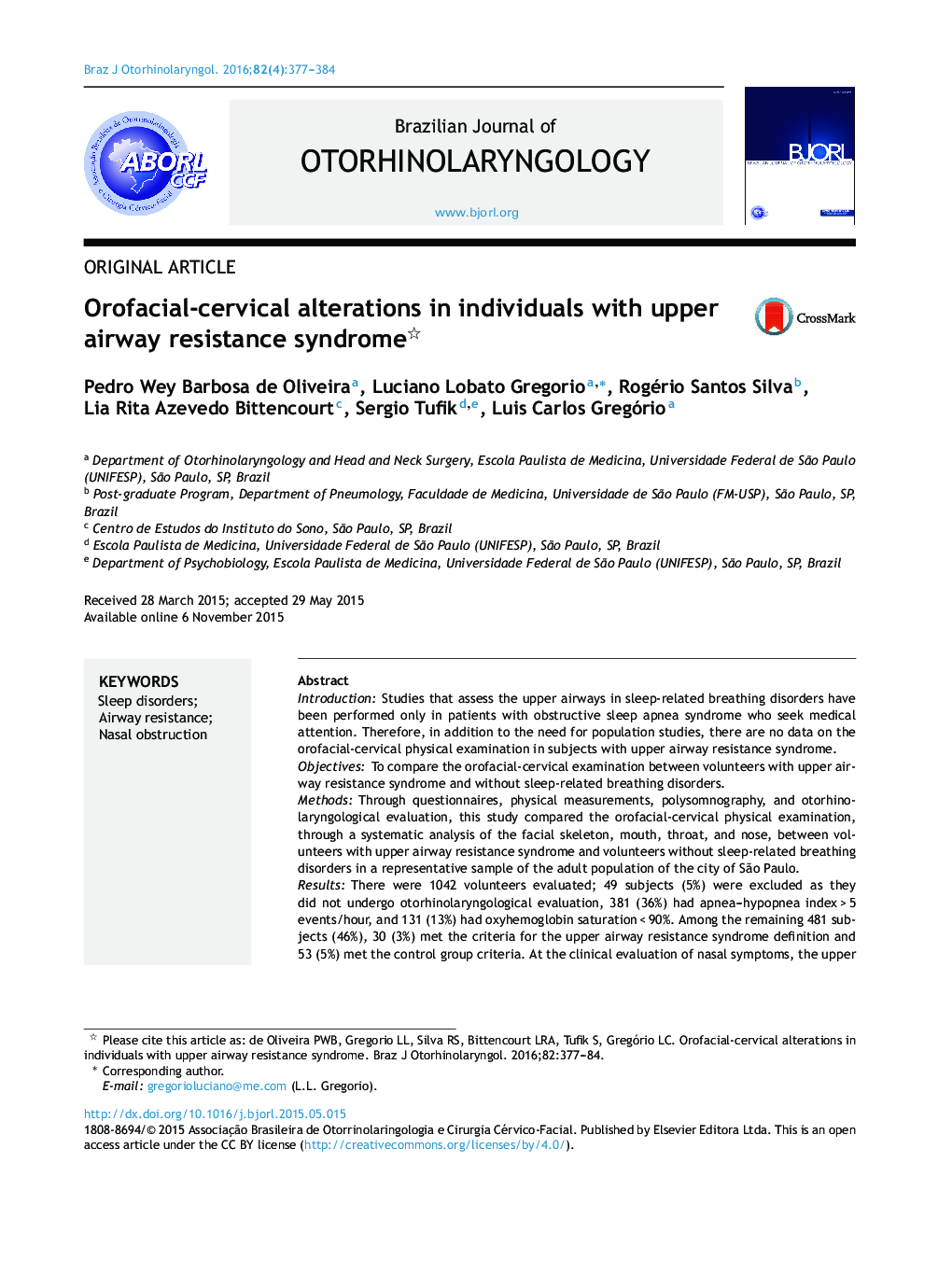| کد مقاله | کد نشریه | سال انتشار | مقاله انگلیسی | نسخه تمام متن |
|---|---|---|---|---|
| 4106098 | 1605360 | 2016 | 8 صفحه PDF | دانلود رایگان |
IntroductionStudies that assess the upper airways in sleep-related breathing disorders have been performed only in patients with obstructive sleep apnea syndrome who seek medical attention. Therefore, in addition to the need for population studies, there are no data on the orofacial-cervical physical examination in subjects with upper airway resistance syndrome.ObjectivesTo compare the orofacial-cervical examination between volunteers with upper airway resistance syndrome and without sleep-related breathing disorders.MethodsThrough questionnaires, physical measurements, polysomnography, and otorhinolaryngological evaluation, this study compared the orofacial-cervical physical examination, through a systematic analysis of the facial skeleton, mouth, throat, and nose, between volunteers with upper airway resistance syndrome and volunteers without sleep-related breathing disorders in a representative sample of the adult population of the city of São Paulo.ResultsThere were 1042 volunteers evaluated; 49 subjects (5%) were excluded as they did not undergo otorhinolaryngological evaluation, 381 (36%) had apnea–hypopnea index > 5 events/hour, and 131 (13%) had oxyhemoglobin saturation < 90%. Among the remaining 481 subjects (46%), 30 (3%) met the criteria for the upper airway resistance syndrome definition and 53 (5%) met the control group criteria. At the clinical evaluation of nasal symptoms, the upper airway resistance syndrome group had more oropharyngeal dryness (17% vs. 29.6%; p = 0.025) and septal deviation grades 1–3 (49.1% vs. 57.7%; p = 0.025) when compared to controls. In the logistic regression model, it was found that individuals from the upper airway resistance syndrome group had 15.6-fold higher chance of having nose alterations, 11.2-fold higher chance of being hypertensive, and 7.6-fold higher chance of complaining of oropharyngeal dryness when compared to the control group.ConclusionSystematic evaluation of the facial skeleton, mouth, throat, and nose, between volunteers with upper airway resistance syndrome and volunteers without sleep-related breathing disorders, showed that the presence of upper airway resistance syndrome is mainly associated with nasal alterations and oropharyngeal dryness, in addition to the risk of hypertension, regardless of gender and obesity.
ResumoIntroduçãoEstudos que avaliam a via aérea superior (VAS) nos distúrbios respiratórios relacionados ao sono (DRRS) foram realizadas somente em pacientes com Síndrome da apneia obstrutiva do sono (SAOS) que procuram o atendimento médico. Portanto, além da necessidade de estudos populacionais, não há dados sobre o exame físico cérvico-orofacial em indivíduos com Síndrome de Resistência das Vias Aéreas Superiores (SRVAS).ObjetivosComparar o exame cérvico orofacial entre voluntário com SRVAS e sem DRRS.MétodoAtravés de questionários, medidas físicas, polissonografia e avaliação otorrinolaringológica comparou-se o exame físico cérvico orofacial, através de uma análise sistemática do esqueleto facial, boca, faringe e nariz, entre voluntários com SRVAS e voluntários sem DRRS em uma amostra representativa da população adulta da cidade de São Paulo.ResultadosAvaliamos 1042 voluntários. Foram excluídos: 49 indivíduos (5%) que não realizaram avaliação otorrinolaringológica; 381 (36%) apresentaram índice de apneia e hipopnéia (IAH) > 5 eventos/hora e 131 (13%) apresentaram saturação da oxihemoglobina < 90%. Entre os 481 voluntários restantes (46%), 30 (3%) preenchiam os critérios estabelecidos para a definição de SRVAS e 53 (5%) que preenchiam os critérios do grupo controle. Na avaliação clínica dos sintomas nasais, o grupo SRVAS apresentou mais ressecamento orofaríngeo (17% vs. 29,6%; p = 0,025), desvio septal grau 1 a 3 (49,1% vs. 57,7%; p = 0,025), comparado ao controle. No modelo de regressão logística observamos que indivíduos do grupo SRVAS apresentaram uma razão de chance 15,6 vezes maior de apresentarem nariz alterado; 11,2 vezes maior de serem hipertensos e 7,6 vezes maior de se queixarem de ressecamento orofaríngeo quando comparados ao grupo controle.ConclusãoA avaliação sistemática do esqueleto facial, boca, faringe e nariz, entre voluntários com SRVAS e voluntários sem DRRS, mostrou que a presença de SRVAS está principalmente associada à alterações nasais e ressecamento orofaríngeo, além do risco de hipertensão arterial, independentemente do gênero e obesidade.
Journal: Brazilian Journal of Otorhinolaryngology - Volume 82, Issue 4, July–August 2016, Pages 377–384
